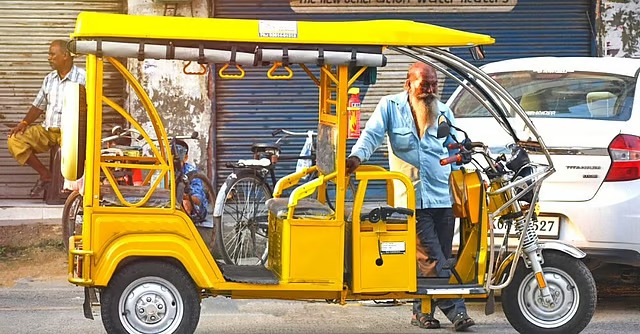M.M. Pareed Pillay, J.@mdashAppellants are Petitioners 1 and 2 in O.P. (Trust) 116 of 1984 of the District Court, Trivandrum. The petition was filed for permission to institute a suit u/s 92 of the CPC for directing the removal of Respondents 2 to 5 from the management of the plaint schedule Asramam, temple and properties, for framing a scheme for the management, of the said items and for appointing a new trustee or board of trustees for its management. The petition was allowed by the court Respondents 2 to 4 filed C.R.P. 871 of 1986 before this Court. The order of the District Court was set aside and it was remitted to that court as there was no finding whether the two Petitioners have any interest in the trust. It is thereafter that the impugned order was passed by the District Judge. The District Judge held that the second Petitioner has failed to prove his interest in the Swayom Prakash Asramam, Kulathoor which is a public trust and hence the first Petitioner alone cannot maintain the petition u/s 92 Code of Civil Procedure.
2. It is only the allegations in the plaint that should be looked into in the first instance to see whether the suit falls within the ambit of Section 92. Of course position would be different when evidence is taken. In Swami Paramatmanand Saraswati v. Ramji Tripathi 1974 S.C.W.R. 429, the Supreme Court held that only the allegations in the plaint that should be looked into in the first instance to see whether the suit falls within the ambit of Section 92 and if after evidence is taken and if it is found that the breach of trust alleged has not been made out and that the prayer for direction of the court is vague and is not based on any solid foundation in facts or reason but is made only with a view to bring the suit under the section, then a suit purporting to be brought u/s 92 must be dismissed.
3. The question that arises for consideration is as to whether P.W. 1 has established any interest in the Asramam so as to invoke the aid of Section 92 of the Code of Civil Procedure. It is argued by the counsel for the Appellants that the evidence of P.W. 1 would show that he is a worshipper in the temple, that he is a resident in the nearby area and that the evidence unfolds his interest in the trust. On the other hand, it is contended by the Respondents that his evidence at best would only show that he worships in the temple and it cannot be said that he has any interest in the Asramam and as the temple is only an adjunct of the Asramam it is difficult to hold that he has any interest in the public trust.
4. Two or more persons having interest in the trust and having obtained the leave of the court can institute a suit for reliefs provided u/s 92. In a suit of the description coming u/s 92 the Plaintiff must have a direct interest in the trust under the English Law. That was the position in India in the Code of 1877. Section 539 of the Code of 1882 also required the Plaintiff in such a suit to have a direct interest in the trust. Later, the requirement of the existence of a direct interest was considered to be not expedient in so far as India was concerned. Hence Section 44 of the CPC (Amendment Act, 1888) omitted the word direct and the amendment widened the class of persons entitled to institute a suit u/s 92. Though the word ''direct'' was omitted and now the Petitioner/Plaintiff has only to satisfy that he has interest in the property in the trust, it does not mean that the person having some remote interest can institute a suit. Even after amendment, the interest contemplated u/s 92 must be a real, substantive and an existing interest in the particular trust. In other words, the interest must be shown to be real, substantive and art existing interest in a particular trust. Mere remote interest or a contingent interest would not be sufficient. At the same time, it is not necessary for Petitioner/Plaintiff to establish his interest in every bit of property stated to be comprised in the trust. The question whether a person has a real, substantive and existing interest in the particular trust so as to maintain an action u/s 92 has to be determined factually on acceptable evidence and also with reference to the trust in relation to which the suit is instituted.
5. Mere residence in the locality and worship in the temple which is the adjunct of the trust will not constitute any interest in the trust u/s 92. The bare possibility that a Hindu visits a particular temple does not give him an interest in the trust. The object of Section 92 is to prevent people from interfering with the administration of public trusts of a charitable or religious nature by instituting frivolous suits with a view to cause sheer harassment or annoyance to the trustees. In Vaidyanatha Ayyar v. Swaminatha Ayyar AIR 1924 P.C. 221, the Privy Council approved the opinion expressed by Sri John Wallis C.J. in T.R. Ramachandra Iyer v. P.A. Parameswara Munbu AIR 1919 Mad. 384 and observed thus:
They agree with Sir John Wallis that the bare possibility, however remote, that a Hindu might desire to resort to a particular temple gives him ah interest in the trust appears to defeat the object with which the Legislature inserted these words in the section. That object was to prevent people interfering by virtue of this section in the administration of charitable trusts merely in to the interests of Ors. and without any real interests of their own.
The Supreme Court in
The interest for filing a suit for framing of a scheme in respect of a choultry should be real, substantive and an existing interest though it need not be a direct one. The mere residence of the Plaintiff in the locality where the choultry is situate is not enough. Even the fact that the Plaintiff might have belonged to the family entitled to the hereditary trusteeship of the temple would not clothe the Plaintiff with the interest of such a nature as to enable him to maintain a suit u/s 92.
6. The learned District Judge held that the evidence of the second Petitioner (P.W. 1) has only made out that he has interest in worshipping in the temple and that he has not established that he has any interest in the public trust which is mainly the Asramam and so it cannot be said that he is a person interested in the public trust. P.W. 1 deposed that he is a resident very near the Asramam, that he is a worshipper in the temple in the Asramam and that he is also interested in the proper functioning of the Asramam. As the temple is only an adjunct of the Asramam and as the second Petitioner confines his claim only as a worshipper in the temple, there is hardly any evidence to hold that he is interested in the affairs of the Asramam. As his evidence does not disclose that he is interested in the affairs of the Asramam, the Court below was justified in passing the impugned order.
There is no merit in the C.M.A. The C.M.A. is dismissed with no order as to costs.

